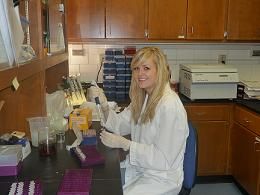Uptake and effects of environmental estrogens on growth of fish

Andrea Hanson is a graduate student (M.S.) in zoology at NDSU. She completed her B.S. in zoology from NDSU in May of 2008. Andrea’s main research focuses on understanding endocrine disruption of the growth hormone (GH)-insulin-like growth factor-1 (IGF-1) system.
andrea.m.hanson@ndsu.edu
Fellow: Andrea Hanson
Advisor: Dr. Mark Sheridan
Degree Progress: M.S. expected in December 2010
Uptake and effects of environmental estrogens on growth of fish
Rapid technological development over the last 60+ years has been accompanied by increased production, use, and disposal of an expanding array of chemicals. As a result, chemicals are introduced into the environment through the air, soil, and water. Increasing research shows the deleterious effects of environmental contamination on microbes, aquatic and terrestrial plants, invertebrates, fish, amphibians, birds, and mammals, including humans (Hester and Harrison, 1999). Chemicals in the environment are known to have numerous toxicological effects, including disruption of the endocrine system of animals.
Of particular concern is a broad spectrum of natural and synthetic compounds that mimic estrogen. Environmental estrogens (EE) include endogenous and synthetic animal estrogens (e.g., 17β-estradiol), phytoestrogens (β-sitosterol), mycotoxins (e.g., zearalenone), organochlorine pesticides (e.g., DDT), polychlorinated biphenyls (PCBs), and alkylphenol polyethoxylates (APEs; e.g., 4-nonylphenol) (Turner, 1999). EE enter soil and water through agricultural (including farm animal production) and veterinary (e.g., diethylstilbesterol, estradiol cypionte; widely used in dogs, cats, and horses) application, manufacturing, natural hydrological processes, and watershed/waste water management practices. Despite the fact that many EE are found at levels below the legal limit, the potential long-term impact of chronic exposure to low levels is not clear, especially given that EE are rapidly transferred through the food web, accumulate in tissues, and can have epigenetic effects to affect progeny (Phllips and Harrison, 1999).
Objectives:
The goal of this project is to use rainbow trout as a model species to assess the biotic contribution to the fate of environmental estrogens in aquatic ecosystems by measuring their uptake and metabolism and by evaluating their impact on animal health as assessed by organismal growth. The hypothesis of this project is that environmental estrogens are taken up by rainbow trout from water and alter postembryonic growth by modulating the growth hormone (GH)-insulin-like growth factor-1 (IGF-1) system.
Significance:
Ultimately, understanding how Hex life history responds to alterations in the lotic environment may allow Hex to serve as the proverbial “canary in the coal mine” to quickly detect the presence of pollution and eutrophication and allow remedial action to be taken.
Expected Outcomes and Significance:
The findings of this project will advance our understanding of EE uptake and metabolism, and for the first time establish whether or not these agents act as endocrine disruptors of growth in a wide-ranging aquatic species. While this work pertains specifically to rainbow trout, because the elements of the GH-IGF-1 system are highly conserved among vertebrates, the findings will have broad relevance to understanding the impact of EE in other aquatic and terrestrial species. Ultimately, this work will inform policies and practices aimed at reducing the impact of EE on aquatic habitats and on the health of wildlife and humans.
Research Outcomes:
Hanson, A. and Sheridan, M.A. Effects of Environmental Estrogens on the Growth Hormone-Insulin-Like-Growth Factor System and Seawater Adaptation of Rainbow Trout. Annual Meeting of the Society for Integrative and Comparative Biology, Seattle, WA, January 4-7, 2010. [Poster]
Hanson, A., Kittilson, J., McCormick, S., and Sheridan, M.A. 2009. Effects of 17β-estradiol, 4-nonylphenol, and β-sitosterol on the growth hormone-insulin-like growth factor system and seawater adaptation of rainbow trout (Oncorhynchus mykiss). Aquaculture, in press.
Presentations:
HANSON, A.M., and SHERIDAN, M.A. 2010. Effects of Environmental Estrogens on the Growth Hormone-Insulin-Like-Growth Factor System and Seawater Adaptation of Rainbow Trout. Presented at the Annual Meeting of the Society for Integrative and Comparative Biology, Seattle, WA, Jan 3-6.
HANSON, A.M., and SHERIDAN, M.A. 2011. Effects of Environmental Estrogens on Organismal Growth and the Growth Hormone-Insulin-Like-Growth Factor System of Rainbow Trout. To be presented at the Annual Meeting of the Society for Integrative and Comparative Biology, Salt Lake City, UT, Jan 4-8.
Publications:
Hanson, A., Kittilson, J.D., McCormick, S.D., Sheridan, M.A. 2010. Effects of 17β-estradiol, 4-nonylphenol, and β-sitosterol on the growth hormone-insulin-like growth factor system and seawater adaptation of rainbow trout (Oncorhynchus mykiss). Aquaculture, in press.

Mark Sheridan
Biological Sciences
North Dakota State University


